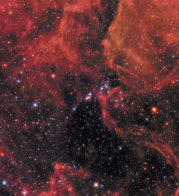
Image credit: Reidar Hahn.
The planned Deep Underground Neutrino Experiment (DUNE) (CERN Courier December 2015 p19) will require 70,000 tonnes of liquid argon, making it the largest experiment of its kind – 100 times larger than the liquid-argon particle detectors that came before. Scientists recently began taking data using a 35 tonne test version of their detector – a significant step towards building the four massive detectors at the Sanford Underground Research Facility (SURF), which will hold the 70,000 tonnes of liquid argon.
Built at the Department of Energy’s Fermi National Accelerator Laboratory, the 35 tonne prototype allows researchers to check that the various detector elements are working properly and to start formal studies. Scientists also use the prototype to assess detector components that have not been tried before. The new parts include redesigned photodetectors – long rectangular prisms with a special coating that changes invisible light to a visible wavelength and bounces the collected light to the detector’s electronic components.
DUNE scientists are also paying special attention to the prototype’s wire planes – pieces that hold the thin wires strung across the detector to pick up electrons. To ensure the frames will fit down the narrow mineshaft at SURF and avoid having to stretch the wires across the long DUNE detectors, risking sagging, scientists plan to use a series of independent 6 m-long and 2.3 m-wide frames. These wire planes should measure tracks in the liquid argon, both in front of and behind them, unlike other detectors.
Engineers have also moved some of the detector’s electronic parts inside the cryostat, which holds liquid argon at –184 °C.
Much like the full detectors, development of the components of the 35 tonne prototype depends on teamwork. For the prototype, Brookhaven and SLAC national laboratories in the US provided much of the electronic equipment; Indiana University, Colorado State University, Louisiana State University and Massachusetts Institute of Technology worked on the light detectors; and the universities of Oxford, Sussex and Sheffield helped to make special digital cameras that can survive in liquid argon, and wrote the software to make sense of the data. Fermilab was responsible for the cryostat and cryogenic support systems.
Scientists will use what they learn from this small prototype version to build one of the full-scale modules for a larger, 400 tonne prototype currently under construction at the CERN Neutrino Platform. A second 400 tonne module using dual-phase technology will also be built at CERN. These will be the final tests before installation of the four huge detectors at SURF for the actual experiment, which is scheduled to start in 2021/2022.





